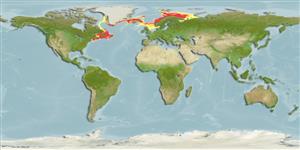Classification / Names
Common names from other countries
Main reference
Size / Weight / Age
Max length : 120 cm TL male/unsexed; (Ref. 9988); common length : 50.0 cm TL male/unsexed; (Ref. 1371); max. published weight: 30.0 kg (Ref. 9988); max. reported age: 20 years (Ref. 1371)
Length at first maturity
Lm 50.0, range 50 - ? cm
Environment
Marine; demersal; oceanodromous (Ref. 51243); depth range 18 - 1000 m (Ref. 1371), usually 18 - 549 m (Ref. 1371)
Climate / Range
Temperate, preferred 10°C (Ref. 107945); 83°N - 37°N, 75°W - 57°E (Ref. 1371)
Distribution
Northwest Atlantic: New Jersey to the Strait of Belle Isle and on the Grand Banks of Newfoundland. Rare at the southern tip of Greenland. Northeast Atlantic: off Iceland, in the northern North Sea, and along the coast of Scandinavia to the Murmansk Coast and at Spitzbergen.
Countries | FAO areas | Ecosystems | Occurrences | Introductions
Short description
Dorsal
spines
(total): 0;
Dorsal
soft rays
(total): 93-103;
Anal
soft rays: 62 - 75;
Vertebrae: 64 - 67. Barbel on present on chin, none on snout, its length equal to eye diameter. Color is variable; dorsally dark red-brown or green brown to yellow shading into pale color on belly. Young specimens may have six transverse yellow bands on sides. Vertical fins with dark margin rimmed with white.
IUCN Red List Status (Ref. 115185)
Threat to humans
Harmless
Human uses
Fisheries: highly commercial; gamefish: yes
More information
ReferencesAquacultureAquaculture profileStrainsGeneticsAllele frequenciesHeritabilityDiseasesProcessingMass conversion
Tools
Special reports
Download XML
Internet sources
Estimates of some properties based on models
Phylogenetic diversity index
PD50 = 1.0000 many relatives (e.g. carps) 0.5 - 2.0 few relatives (e.g. lungfishes)
Trophic Level
3.9 ±0.3 se; Based on diet studies.
Resilience
Low, minimum population doubling time 4.5 - 14 years (K=0.08-0.16; tm=8-10; tmax=20; Fec=2 million)
Vulnerability
High vulnerability (63 of 100)
Price category
